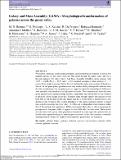Files in this item
Galaxy and Mass Assembly (GAMA) : morphological transformation of galaxies across the green valley
Item metadata
| dc.contributor.author | Bremer, M. N. | |
| dc.contributor.author | Phillipps, S. | |
| dc.contributor.author | Kelvin, L. S. | |
| dc.contributor.author | Propris, R. De | |
| dc.contributor.author | Kennedy, Rebecca | |
| dc.contributor.author | Moffett, Amanda J. | |
| dc.contributor.author | Bamford, S. | |
| dc.contributor.author | Davies, L. J. M. | |
| dc.contributor.author | Driver, S. P. | |
| dc.contributor.author | Häußler, B. | |
| dc.contributor.author | Holwerda, B. | |
| dc.contributor.author | Hopkins, A. | |
| dc.contributor.author | James, P. A. | |
| dc.contributor.author | Liske, J. | |
| dc.contributor.author | Percival, S. | |
| dc.contributor.author | Taylor, E. N. | |
| dc.date.accessioned | 2018-03-16T15:30:09Z | |
| dc.date.available | 2018-03-16T15:30:09Z | |
| dc.date.issued | 2018-05-01 | |
| dc.identifier | 252572386 | |
| dc.identifier | f57e5ee4-3433-45cd-bc5b-902cd574ce8f | |
| dc.identifier | 85043505438 | |
| dc.identifier | 000429276700002 | |
| dc.identifier.citation | Bremer , M N , Phillipps , S , Kelvin , L S , Propris , R D , Kennedy , R , Moffett , A J , Bamford , S , Davies , L J M , Driver , S P , Häußler , B , Holwerda , B , Hopkins , A , James , P A , Liske , J , Percival , S & Taylor , E N 2018 , ' Galaxy and Mass Assembly (GAMA) : morphological transformation of galaxies across the green valley ' , Monthly Notices of the Royal Astronomical Society , vol. 476 , no. 1 , pp. 12-26 . https://doi.org/10.1093/mnras/sty124 | en |
| dc.identifier.issn | 0035-8711 | |
| dc.identifier.other | ArXiv: http://arxiv.org/abs/1801.04277v1 | |
| dc.identifier.uri | https://hdl.handle.net/10023/12964 | |
| dc.description.abstract | We explore constraints on the joint photometric and morphological evolution of typical low redshift galaxies as they move from the blue cloud through the green valley and on to the red sequence. We select Galaxy And Mass Assembly (GAMA) survey galaxies with 10.25 < log(M*/M⊙) < 10.75 and z < 0.2 classified according to their intrinsic u* − r* colour. From single component Sérsic fits, we find that the stellar mass-sensitive K-band profiles of red and green galaxy populations are very similar while g-band profiles indicate more disc-like morphologies for the green galaxies: apparent (optical) morphological differences arise primarily from radial mass-to-light ratio variations. Two-component fits show that most green galaxies have significant bulge and disc components and that the blue to red evolution is driven by colour change in the disc. Together, these strongly suggest that galaxies evolve from blue to red through secular disc fading and that a strong bulge is present prior to any decline in star formation. The relative abundance of the green population implies a typical time-scale for traversing the green valley ∼1–2 Gyr and is independent of environment, unlike that of the red and blue populations. While environment likely plays a rôle in triggering the passage across the green valley, it appears to have little effect on time taken. These results are consistent with a green valley population dominated by (early type) disc galaxies that are insufficiently supplied with gas to maintain previous levels of disc star formation, eventually attaining passive colours. No single event is needed to quench their star formation. | |
| dc.format.extent | 1512042 | |
| dc.language.iso | eng | |
| dc.relation.ispartof | Monthly Notices of the Royal Astronomical Society | en |
| dc.subject | Galaxies: bulges | en |
| dc.subject | Galaxies: evolution | en |
| dc.subject | Galaxies: star formation | en |
| dc.subject | Galaxies: stellar content | en |
| dc.subject | Galaxies: structure | en |
| dc.subject | QB Astronomy | en |
| dc.subject | QC Physics | en |
| dc.subject | DAS | en |
| dc.subject.lcc | QB | en |
| dc.subject.lcc | QC | en |
| dc.title | Galaxy and Mass Assembly (GAMA) : morphological transformation of galaxies across the green valley | en |
| dc.type | Journal article | en |
| dc.contributor.institution | University of St Andrews. School of Physics and Astronomy | en |
| dc.identifier.doi | https://doi.org/10.1093/mnras/sty124 | |
| dc.description.status | Peer reviewed | en |
This item appears in the following Collection(s)
Items in the St Andrews Research Repository are protected by copyright, with all rights reserved, unless otherwise indicated.

